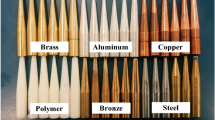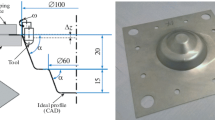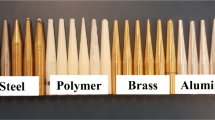Abstract
Single point incremental forming (SPIF) is a flexible, innovative, and cheap process for rapid manufacturing of complex sheet metal parts. It is a crucial task for engineers to predict a process when many independent parameters are affecting simultaneously its performance. An artificial neural network (ANN) based prediction model was developed to evaluate average surface roughness (R a) and maximum forming angle (Ø max) while SPIF forming of AA5052-H32 material. A feedforward backpropagation network with Levenberg—Marquardt algorithm was employed to build ANN model. The ANNs (4-n-1, 4-n-2) were generated by introducing different combinations of transfer functions and a number of neurons. The confirmation runs were performed to verify the agreement between the ANN predicted and the experimental results. The developed ANN model (4-n-1) was capable of predicting the process response with an excellent accuracy and resulted in overall R-value, MSE, and MAPE of 0.99807, 0.0209, and 5.96% for R a 0.99913, 0.0281, and 0.003 for Ø max. The optimum 4-n-2 model was built with overall R-value, MSE of 0.99999 and 0.057194, respectively. Hence, it was found that the engineering efforts may be reduced in the SPIF process with successful ANN model implementation.
Similar content being viewed by others
References
G. Buffa, D. Campanella, L. Fratini, On the improvement of material formability in SPIF operation through tool stirring action, Int. J. Adv. Manuf. Technol. 66 (2013) 1343–1351.
X. Ziran, L. Gao, G. Hussain, Z. Cui, The performance of flat end and hemispherical end tools in single-point incremental forming, Int. J. Adv. Manuf. Technol. 46 (2010) 1113–1118.
G. Hussain, L. Gao, Z.Y. Zhang, Formability evaluation of a pure titanium sheet in the cold incremental forming process, Int. J. Adv. Manuf. Technol. 37 (2008) 920–926.
G. Ambrogio, L. Filice, F. Guerriero, R. Guido, D. Umbrello, Prediction of incremental sheet forming process performance by using a neural network approach, Int. J. Adv. Manuf. Technol. 54 (2011) 921–930.
Z. Liu, S. Liu, Y. Li, P. Meehan, Modelling and optimization of surface roughness in incremental sheet forming using a multi-objective function, Mater. Manuf. Process. 29 (2014) 808–818.
M. Durante, a. Formisano, A. Langella, F.M. Capece Minutolo, The influence of tool rotation on an incremental forming process, J. Mater. Process. Technol. 209 (2009) 4621–4626.
N.G. Azevedo, J.S. Farias, R.P. Bastos, P. Teixeira, J.P. Davim, R. J. Alves de Sousa, Lubrication aspects during single point incremental forming for steel and aluminum materials, Int. J. Precis. Eng. Manuf. 16 (2015) 589–595.
M. Ham, J. Jeswiet, Single point incremental forming limits using a Box-Behnken design of experiment, Key Eng. Mater. 344 (2007) 629–636.
I. Cerro, E. Maidagan, J. Arana, a. Rivero, P.P. Rodriguez, Theoretical and experimental analysis of the dieless incremental sheet forming process, J. Mater. Process. Technol. 177 (2006) 404–408.
S.P. Shanmuganatan, V.S. Senthil Kumar, Experimental investigation and finite element modeling on profile forming of conical component using Al 3003(0) alloy, Mater. Des. 36 (2012) 564–569.
S. Golabi, H. Khazaali, Determining frustum depth of 304 stainless steel plates with various diameters and thicknesses by incremental forming, J. Mech. Sci. Technol. 28 (2014) 3273–3278.
Z. Cui, Z. Cedric Xia, F. Ren, V. Kiridena, L. Gao, Modeling and validation of deformation process for incremental sheet forming, J. Manuf. Process. 15 (2013) 236–241.
M. Bambach, B. Taleb Araghi, G. Hirt, Strategies to improve the geometric accuracy in asymmetric single point incremental forming, Prod. Eng. 3 (2009) 145–156.
A. Attanasio, E. Ceretti, C. Giardini, L. Mazzoni, Asymmetric two points incremental forming: improving surface quality and geometric accuracy by tool path optimization, J. Mater. Process. Technol. 197 (2008) 59–67.
Y.H. Kim, J.J. Park, Effect of process parameters on formability in incremental forming of sheet metal, J. Mater. Process. Technol. 130–131 (2002) 42–46.
M.S. Shim, J.J. Park, The formability of aluminium sheet in incremental forming, J. Mater. Process. Technol. 113 (2001) 654–658.
V. Mugendiran, A. Gnanavelbabu, R. Ramadoss, Parameter optimization for surface roughness and wall thickness on AA5052 aluminium alloy by incremental forming using response surface methodology, Procedia Eng. 97 (2014) 1991–2000.
F.C. Minutolo, M. Durante, A. Formisano, A. Langella, Evaluation of the maximum slope angle of simple geometries carried out by incremental forming process, J. Mater. Process. Technol. 193 (2007) 145–150.
M.J. Mirnia, B. Mollaei Dariani, H. Vanhove, J.R. Duflou, Thickness improvement in single point incremental forming deduced by sequential limit analysis, Int. J. Adv. Manuf. Technol. 70 (2014) 2029–2041.
J.R. Duflou, B. Callebaut, J. Verbert, H. De Baerdemaeker, Improved SPIF performance through dynamic local heating, Int. J. Mach. Tools Manuf. 48 (2008) 543–549.
J.J. Park, Y.H. Kim, Fundamental studies on the incremental sheet metal forming technique, J. Mater. Process. Technol. 140 (2003) 447–453.
G. Hussain, L. Gao, N. Hayat, L. Qijian, The effect of variation in the curvature of part on the formability in incremental forming: an experimental investigation, Int. J. Mach. Tools Manuf. 47 (2007) 2177–2181.
A. Bhattacharya, K. Maneesh, N. Venkata Reddy, J. Cao, Formability and surface finish studies in single point incremental forming, J. Manuf. Sci. Eng. 133 (2011) 061020, https://doi.org/10.1115/l.4005458.
B. Riadh, A. Henia, B. Hedi, Application of response surface analysis and genetic algorithm for the optimization of single point incremental forming process, Key Eng. Mater. 557 (2013) 1265–1272.
Z. Liu, Y. Li, P.A. Meehan, Experimental investigation of mechanical properties, formability and force measurement for AA7075-O aluminum alloy sheets formed by incremental forming, Int. J. Precis. Eng. Manuf. 14 (2013) 1891–1899.
S. Kurra, S.P. Regalia, Experimental and numerical studies on formability of extra-deep drawing steel in incremental sheet metal forming, Integr. Med. Res. 3 (2014) 158–171.
S. Kurra, N.H. Rahman, S.P. Regalla, A.K. Gupta, Modeling and optimization of surface roughness in single point incremental forming process, J. Mater. Res. Technol. 4 (2015) 304–313.
V. Gulati, A. Aryal, P. Katyal, A. Goswami, Process parameters optimization in single point incremental forming, J. Inst. Eng. (India): Ser. C 97 (2015) 221–229.
G. Palumbo, M. Brandizzi, Experimental investigations on the single point incremental forming of a titanium alloy component combining static heating with high tool rotation speed, Mater. Des. 40 (2012) 43–51.
A. Mulay, S. Ben, S. Ismail, A. Kocanda, Experimental investigations into the effects of SPIF forming conditions on surface roughness and formability by design of experiments, J. Braz. Soc. Mech. Sci. Eng. (2017), https://doi.org/10.1007/S40430-016-0703-7.
M. Honarpisheh, M. Jobedar, M. Alinaghian, Multi-response optimization on single-point incremental forming of hyperbolic shape Al-1050/Cu bimetal using response surface methodology, Int. J. Adv. Manuf. Technol. 96 (2018) 3069–3080.
G. Liu, Z. Li, Single point incremental forming of Cu-Al composite sheets: a comprehensive study on deformation behaviors, Arch. Civ. Mech. Eng. 19 (2019) (2019) 484–502.
A. Kumar, V. Gulati, Experimental investigation and optimisation of surface roughness in negative incremental forming, Measurement 131 (2019) 419–430.
S. Park, C.G Lee, H.N. Han, S.-J. Kim, K. Chung, Improvement of the drawability based on the surface friction stir process of AA5052-H32 automotive sheets, Met. Mater. Int. 14 (2008) 47–57.
M. Mia, N. Ranjan, Prediction of surface roughness in hard turning under high pressure coolant using artificial neural network, Measurement 92 (2016) 464–474.
M.T. Hagan, M.B. Menhaj, Training feedforward networks with the Marquardt algorithm, IEEE Trans. Neural Netw. 5 (1994) 2–6.
M.R. Thakker, J.K. Parikh, M.A. Desai, Microwave assisted extraction of essential oil from the leaves of Palmarosa: multi-response optimization and predictive modelling, Ind. Crops Prod. 86 (2016) 311–319.
A. Chakraborty, S. Roy, R. Banerjee, An experimental based ANN approach in mapping performance- emission characteristics of a diesel engine operating in dual-fuel mode with LPG, J. Nat. Gas Sci. Eng. 28 (2016) 15–30.
T.T. Nguyen, Y.S. Yang, K.Y. Bae, S.N. Choi, Prediction of deformations of steel plate by artificial neural network in forming process with induction heating, J. Mech. Sci. Technol. 23 (2009) 1211–1221.
S. Roy, R. Banerjee, A.K. Das, P.K. Bose, Development of an ANN based system identification tool to estimate the performance-emission characteristics of a CRDI assisted CNG dual fuel diesel engine, J. Nat. Gas Sci. Eng. 21 (2014) 147–158.
Author information
Authors and Affiliations
Corresponding author
Rights and permissions
About this article
Cite this article
Mulay, A., Ben, B.S., Ismail, S. et al. Prediction of average surface roughness and formability in single point incremental forming using artificial neural network. Archiv.Civ.Mech.Eng 19, 1135–1149 (2019). https://doi.org/10.1016/j.acme.2019.06.004
Received:
Revised:
Accepted:
Published:
Issue Date:
DOI: https://doi.org/10.1016/j.acme.2019.06.004




